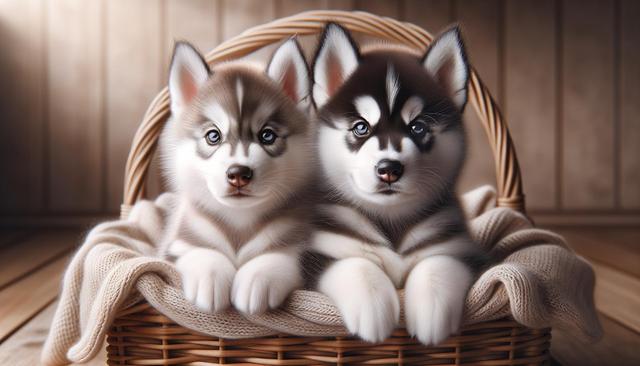Understanding the Siberian Husky Breed
Siberian Huskies hail from the cold regions of northeastern Asia, originally bred by the Chukchi people for sled pulling and companionship. These dogs are admired for their wolf-like looks, including almond-shaped blue or multicolored eyes, thick double coats, and erect ears. While their appearance draws many admirers, it’s essential to understand the breed’s characteristics before bringing a Siberian Husky puppy home. Huskies are highly energetic and intelligent, which means they require plenty of physical and mental stimulation. Without proper outlets for their energy, they can become bored and destructive. Their independent nature can also make training a challenge for first-time dog owners.
They are also known for their strong prey drive and natural inclination to run, which means secure fencing and leash training are crucial. Typically, Siberian Huskies are not aggressive, but they are very social and thrive in environments where they receive plenty of human interaction or have other canine companions. Understanding these traits helps in creating a safe and nurturing environment for your puppy to grow into a well-adjusted adult dog.
Preparing Your Home for a Husky Puppy
Bringing a Siberian Husky puppy into your home requires thoughtful preparation. These puppies are curious and adventurous, so puppy-proofing your home is a necessary first step. Start by removing or securing items that a puppy might chew or swallow, such as electrical cords, shoes, and small household objects. Additionally, invest in durable toys and chews to help with teething and to keep them mentally engaged.
Consider the following essentials before your puppy arrives:
- A spacious crate for training and safety
- Food and water bowls made from stainless steel or ceramic
- A high-quality puppy food formulated for medium to large breeds
- Grooming tools like brushes and nail clippers
- A secure, fenced-in yard or play area
Also, create a routine early on. Consistency in feeding, potty breaks, and training sessions will help your puppy adjust quickly and begin learning essential behaviors. Begin socializing your puppy by introducing them to different environments, sounds, and people to build their confidence.
Training and Socialization Tips
Training a Siberian Husky puppy is both rewarding and challenging. These dogs are intelligent and capable of learning a wide variety of commands, but their stubborn streak means they often like to do things on their own terms. Positive reinforcement techniques are the most effective approach—using treats, praise, and play as rewards encourages good behavior without creating fear or stress.
Key areas to focus on include:
- Basic obedience commands like sit, stay, and come
- Leash training to prevent pulling and running off
- Crate training for housebreaking and safety
- Socialization with other dogs, people, and environments
Start training early, ideally at 8 to 10 weeks of age, and keep sessions short and engaging. Huskies can get bored easily, so mix up activities and make learning fun. Enrolling in puppy training classes can also provide structure and expert guidance, while offering valuable socialization opportunities for your dog.
Exercise and Mental Stimulation
One of the most important aspects of caring for a Siberian Husky puppy is providing enough physical and mental activity. This breed was developed to work and run long distances, so daily exercise is non-negotiable. Puppies don’t need the same intense activity level as adults, but they do need frequent play sessions and short walks appropriate for their age and development stage.
As your puppy grows, gradually increase the duration and intensity of physical activity. Some excellent ways to meet their exercise needs include:
- Interactive games like fetch and tug-of-war
- Structured walks and hikes
- Running in a secure, enclosed area
- Agility and obedience training sessions
Mental stimulation is just as important. Puzzle toys, scent games, and training new tricks can keep your Husky puppy mentally active. Without proper stimulation, boredom can lead to unwanted behaviors like digging, chewing, or howling. A tired Husky is a happy Husky, so be proactive in planning their activities.
Health Care and Grooming Needs
Siberian Huskies are generally healthy dogs, but like all breeds, they are prone to certain health conditions. Regular veterinary check-ups and vaccinations are essential in the first year to ensure your puppy grows up strong and healthy. Common health concerns include hip dysplasia, eye issues like cataracts, and certain skin conditions. Working with a reputable breeder who provides health screenings can reduce the risk of genetic problems.
Grooming is another key part of caring for a Siberian Husky. Their thick double coat sheds year-round and blows out twice a year—usually in spring and fall. Regular brushing, at least twice a week, helps manage shedding and maintains coat health. During heavy shedding seasons, daily brushing might be necessary. Huskies are known for being relatively clean dogs with little odor, but occasional baths will help keep them fresh.
Other grooming tasks include:
- Regular nail trimming
- Ear cleaning to prevent infections
- Dental care with brushing or dental chews
Establishing a grooming routine early in life helps your puppy become comfortable with being handled, which is beneficial for both at-home care and vet visits.
Conclusion: Is a Siberian Husky Puppy Right for You?
Siberian Husky puppies are captivating, energetic, and full of personality. They bring joy and companionship to homes that can meet their specific needs. If you’re active, have the time and patience for training, and are prepared for a high-energy dog with a strong personality, a Husky might be a wonderful addition to your family. With proper care, socialization, and attention, these dogs can grow into loyal and affectionate companions who thrive in a stimulating and loving environment.




Leave a Reply